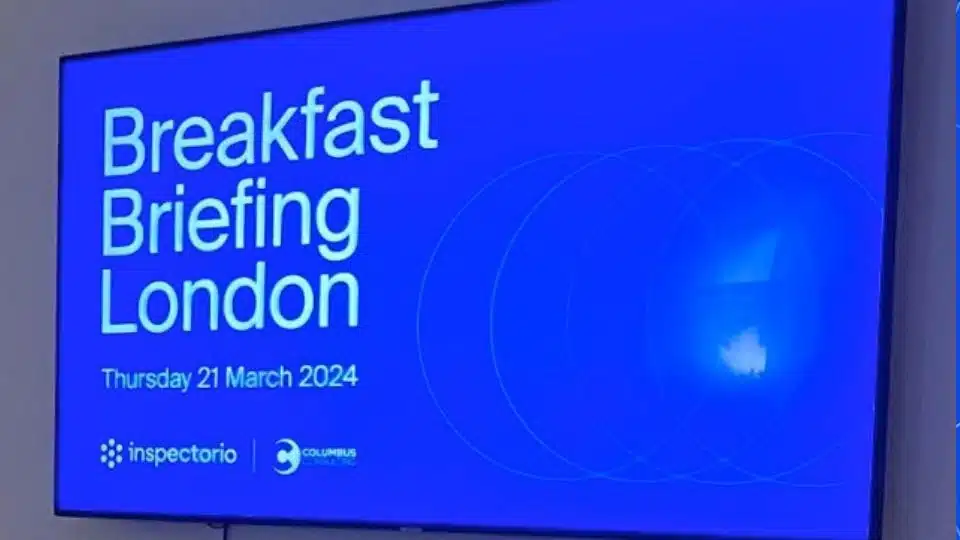On March 21, 2024, global retail leaders met at The Langham, London for a breakfast briefing hosted by Inspectorio and Columbus Consulting. The invitation-only event brought together brands including Mango, ASOS, PVH, and Hunkemöller to discuss and share the most effective supplier practices. The industry has long leveraged dashboards and business key performance indexes to monitor their health and progress, but today’s market demands more. Suppliers and the entire supply chain have proven to be key partners throughout the product life cycle and are influential in driving retailer profit. Layer on the emerging sustainability, ESG requirements and legislation, along with the common framework for responsible purchasing practices (CFRPP), and suppliers are playing an even greater role in determining retailers’ success.

WHAT IS THE IDEAL SUPPLIER SCORECARD?
While data inputs may vary, most retailers agree that the ideal supplier scorecard needs to be a combination of both quantitative and qualitative measures. It needs to be connected and dynamic, capturing information that helps the business make decisions and not just learn about specific moments in time. Scorecards must be adaptable and flex when needed as conditions change. Textile shortages, transportation interruptions, political variables and more can all disrupt business as usual. How you review and measure/track your business needs to accommodate those unforeseen conditions. Some of the top KPIs that should be part of a modern scorecard include:
- Quality measures
- Delivery time/on-time delivery rates
- Markup trends
- Sustainability requirements
- Ethics/social standards
- Price of goods and related services
- Communication effectiveness
- Partnership commitment
This mix of both data and emotional indicators are necessary to define supplier rank and value. If obtaining the supplier’s lowest costs come with weak social practices, retailers should be cautioned. Similarly, having high quality marks but inconsistent deliveries may taint the overall success of that supplier partnership.
Defining the key indicators is only the first step in establishing an ideal scorecard; these metrics must also be aligned with the business goals and need to be connected to other cross-functional teams who are collaborators. Having standardised measures is imperative to not only creating synergy, but ensuring mutual success across the organisation and its related brands and categories.
KEY CHALLENGES IN BUILDING AND MANAGING SCORECARDS:
There are varied challenges in building/using scorecards that may apply to different types of brands/retailers/categories, but overall, the team at the breakfast briefing agreed that there are collective obstacles. Top of list are:
- Maintaining scorecards for only top tier suppliers
- Creating more rigid measures that only apply to specific teams and are not adaptable
- Utilising incorrect or incomplete data to build the scorecards
- Lack of data governance/process consistency/incomplete training/human error
- Infrequency of monitoring the scorecards
- Lack of scoring thresholds to address and course correct lowering scores
- Lack of clarity and prioritisation of key business goals
- Utilizing only data inputs and not considering qualitative measures
- Approaching scorecards with emotion rather than with unhindered consistency across suppliers (compare apples with apples)
- Not implementing a communication plan for both internal and external sharing
- Not defining success upfront
Even with the challenges, retailers agree that scorecards are the best way to audit, evaluate, assess, select, prioritise and manage partnerships. They help organisations build clear accountability, take the emotion out of decisions and build efficiencies. Scorecards have practical applications like helping to streamline the number of vendors, aligning volume with better partners, ensuring diversification throughout the supply chain and helping the entire organisation keep a consistent “north star.”
RECAP FINDINGS:
Having a standardised accounting of suppliers is beneficial on many levels, but is not a black and white solution to building and growing relationships. Retailers agree that brands have human elements involved in the business. Whether you are a designer who drives more art than commerce or a mass/fast fashion brand who relies more on volume and speed—aka, science, every supplier/partnership starts somewhere. Success amounts to how you nurture the relationship, provide feedback and properly communicate the benchmarks for success. In sum:
- Align scorecards to company strategy (if price is key to a retailer’s value proposition then this should be the highest weighting on the scorecard, if sustainability is of greater importance, then that should be at the top).
- Build an “ideal” scorecard– this could be company specific or category/brand specific and use the scorecard as a tool to take current suppliers on the company’s “journey” and to on-board new suppliers.
- If there are multiple brands within the group that all use the same suppliers then there should be alignment with a “group scorecard.” Individual brands may need some scorecard variation if they have different strategic goals.
- Smaller brands should work with their suppliers to build their KPIs, especially when they are not the largest retailer with those suppliers – this will build partnerships and buy-in.
Scorecards, like all business tools, are only as valuable as they work for an organisation. They are incredibly valuable in keeping the business on track, evaluating performance, improving efficiencies and expediting decisions. The risks need equal consideration as not to derail the benefits. Don’t know where to start? You are not alone. Even the early scorecard adopters are still discussing ways to improve the process/system and continue to strive to be more resilient and accommodating as the business pivots and consumer demands change. Working with experts who have worked on scorecards across industries, types of retailers and countries is a safer way to ensure success—both short and long-term.
ABOUT INSPECTORIO
Inspectorio is the leading AI-powered supply chain platform. The Inspectorio platform optimizes performance, builds resilience, and provides intelligence across production chains for global brands, retailers, and their multi-tier suppliers. Our innovative platform seamlessly connects and digitizes supply chain processes to optimize decision-making while providing real-time visibility and control over production chain operations. Today, Inspectorio is used by over 12,000 customers, including some of the largest brands and retailers in the world. Headquartered in Minneapolis, MN, Inspectorio has over 200 employees across the United States, Ecuador, China, Vietnam, and Belarus. For more information, visit www.Inspectorio.com.
ABOUT COLUMBUS CONSULTING
Columbus Consulting delivers solutions that drive true value and have been transforming the retail and CPG industries for over two decades. We are a retail consulting company of industry experts. Our approach is simple, if you do it, we do it. We are more than consultants; we are experienced practitioners who actually sat in our clients’ seats. We understand the challenges, know what questions to ask and deliver the right solutions. Columbus offers a unique, consumer-centric approach with an end-to-end perspective that bridges functional & organization silos from strategy to execution. Our specialties include: unified commerce, merchandising & category management, planning & inventory management, sourcing & supply chain, data & analytics, accounting, finance & operations, people & organization and information technology. Let us know how we can help you. To learn more, visit COLUMBUSCONSULTING.COM.

